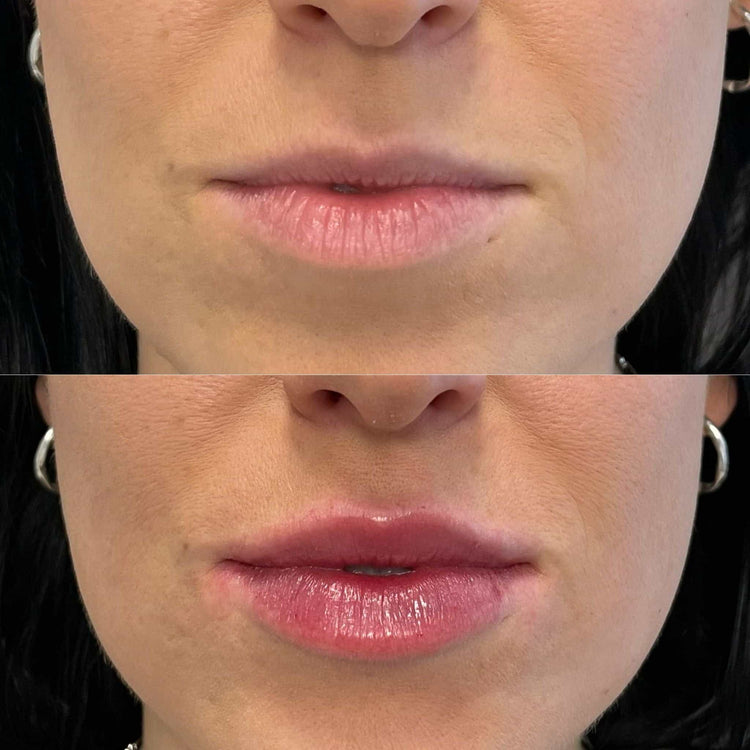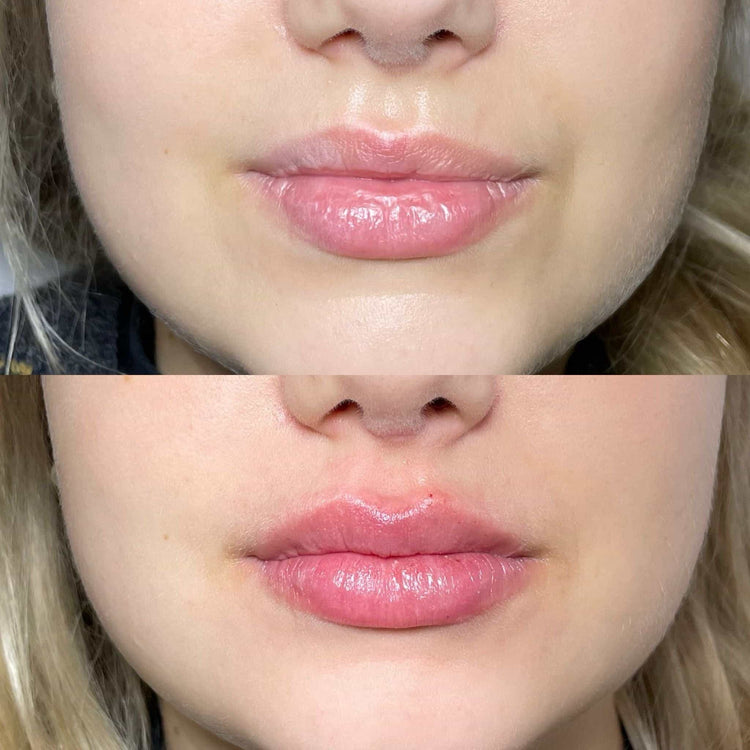How Lip Filler Dissolution Works
Lip fillers are a popular cosmetic treatment for enhancing lip shape and volume. But what happens when you want to change your look or simply reverse the effects of lip filler? Luckily, there’s a solution: dissolution. This process involves using an enzyme called hyaluronidase to break down hyaluronic acid, the primary ingredient in most lip fillers.
The Science Behind Dissolving Hyaluronic Acid
Lip fillers are a popular cosmetic treatment for enhancing lip shape and volume. But what happens when you want to change your look or simply reverse the effects of lip filler? Luckily, there’s a solution: dissolution. This process involves using an enzyme called hyaluronidase to break down hyaluronic acid, the primary ingredient in most lip fillers.
Hyaluronic acid is naturally found in the body and acts as a humectant, attracting and holding water molecules. This gives lips their plumpness and hydration. When injected into the lips, hyaluronic acid fillers temporarily increase volume and smooth out fine lines.
- Hyaluronidase works by breaking down the bonds between hyaluronic acid molecules.
- Once these bonds are broken, the hyaluronic acid filler is gradually absorbed by the body.
- The process usually takes a few hours to a couple of days.
It’s important to note that hyaluronidase can only dissolve hyaluronic acid fillers. It won’t affect other types of fillers, such as those based on poly-L-lactic acid or calcium hydroxylapatite.
The Role of Hyaluronidase Enzyme
Hyaluronic acid is a naturally occurring substance in the body responsible for hydration and plumpness. When used as a filler, it temporarily increases lip volume and smooths wrinkles. Hyaluronidase is an enzyme that specifically breaks down hyaluronic acid.
The process of dissolving lip fillers involves injecting hyaluronidase into the treated area. Hyaluronidase works by breaking the bonds holding hyaluronic acid molecules together. Once these bonds are broken, the hyaluronic acid filler is gradually absorbed by the body.
This dissolution process typically takes a few hours to a couple of days.
Dissolution Process
Lip fillers are made primarily of hyaluronic acid, a substance naturally found in the body that attracts and holds water. This gives lips their plumpness and hydration. When injected as a filler, it temporarily increases volume and smooths out fine lines.
To dissolve lip fillers, an enzyme called hyaluronidase is used. Hyaluronidase works by breaking down the bonds between hyaluronic acid molecules. Once these bonds are broken, the hyaluronic acid filler is gradually absorbed by the body.
The process of dissolving lip fillers typically takes a few hours to a couple of days.
Factors Affecting Dissolution Rate
Lip fillers are made primarily of hyaluronic acid, a substance naturally found in the body that attracts and holds water. This gives lips their plumpness and hydration. When injected as a filler, it temporarily increases volume and smooths out fine lines.
To dissolve lip fillers, an enzyme called hyaluronidase is used. Hyaluronidase works by breaking down the bonds between hyaluronic acid molecules. Once these bonds are broken, the hyaluronic acid filler is gradually absorbed by the body.
The process of dissolving lip fillers typically takes a few hours to a couple of days.
Several factors can affect how quickly the fillers dissolve. The amount of filler injected, the type of hyaluronic acid used, and individual body chemistry all play a role.
Filler Type and Concentration
Lip fillers are primarily composed of hyaluronic acid, a naturally occurring substance in the body that attracts and holds water, giving lips their plumpness. When injected as a filler, it temporarily increases volume and smooths fine lines.
To dissolve these fillers, hyaluronidase is used. Hyaluronidase is an enzyme that specifically breaks down hyaluronic acid bonds, causing the filler to be gradually absorbed by the body.
The dissolution process typically takes a few hours to a couple of days. Factors influencing the speed of dissolution include the amount of filler injected, the specific type of hyaluronic acid used, and individual body chemistry.
It is important to note that hyaluronidase only dissolves hyaluronic acid fillers. It does not affect other types of fillers such as those based on poly-L-lactic acid or calcium hydroxylapatite.
Injection Technique
Lip filler dissolution involves the use of an enzyme called hyaluronidase, which is specifically designed to break down hyaluronic acid. Hyaluronic acid is the primary component of most lip fillers and is naturally found in the body, responsible for hydration and plumpness.

When injected, hyaluronidase works by targeting the bonds between hyaluronic acid molecules within the filler. By breaking these bonds, the hyaluronic acid structure is disrupted, causing it to gradually be absorbed by the body.
The entire process typically takes a few hours to a couple of days. The speed of dissolution can vary depending on factors like the amount of filler injected, the type of hyaluronic acid used, and individual body chemistry.
Individual Body Chemistry
Lip filler dissolution involves the use of an enzyme called hyaluronidase. This enzyme is specifically designed to break down hyaluronic acid, the main component of most lip fillers.
Hyaluronic acid naturally occurs in the body, attracting and holding water molecules, which gives lips their plumpness and hydration. When injected as a filler, it temporarily increases volume and smoothness. Hyaluronidase works by targeting the bonds between hyaluronic acid molecules within the filler.
Breaking these bonds causes the hyaluronic acid structure to be disrupted, leading to its gradual absorption by the body. The process of dissolution typically takes a few hours to a couple of days.
Individual body chemistry plays a role in how quickly fillers dissolve. Some individuals may metabolize hyaluronic acid faster than others, influencing the duration of the dissolution process.
Risks and Side Effects
Lip filler dissolution involves using an enzyme called hyaluronidase. This enzyme is specifically designed to break down hyaluronic acid, the primary component of most lip fillers. Hyaluronic acid naturally occurs in the body and attracts water molecules, giving lips their plumpness and hydration.

When injected as a filler, it temporarily increases volume and smoothness. Hyaluronidase works by targeting the bonds between hyaluronic acid molecules within the filler.
Breaking these bonds causes the hyaluronic acid structure to be disrupted, leading to its gradual absorption by the body. The process of dissolution typically takes a few hours to a couple of days.
Several factors can affect how quickly fillers dissolve, including the amount of filler injected, the type of hyaluronic acid used, and individual body chemistry.
It’s important to note that hyaluronidase only dissolves hyaluronic acid fillers and won’t affect other types of fillers, such as those based on poly-L-lactic acid or calcium hydroxylapatite.
Potential risks and side effects of lip filler dissolution include temporary swelling, redness, bruising, tenderness, and itching at the injection site.
In rare cases, more serious side effects like allergic reactions or infections can occur. It’s crucial to consult with a qualified medical professional before undergoing any type of filler dissolution procedure.
Bruising and Swelling
Lip filler dissolution involves the use of an enzyme called hyaluronidase, which is specifically designed to break down hyaluronic acid, the main component of most lip fillers.
Hyaluronic acid naturally occurs in the body and attracts water molecules, giving lips their plumpness and hydration. When injected as a filler, it temporarily increases volume and smoothness. Hyaluronidase works by targeting the bonds between hyaluronic acid molecules within the filler.
Breaking these bonds causes the hyaluronic acid structure to be disrupted, leading to its gradual absorption by the body. The process of dissolution typically takes a few hours to a couple of days.
Several factors can affect how quickly fillers dissolve, including the amount of filler injected, the type of hyaluronic acid used, and individual body chemistry.
It’s important to note that hyaluronidase only dissolves hyaluronic acid fillers and won’t affect other types of fillers, such as those based on poly-L-lactic acid or calcium hydroxylapatite.
Potential risks and side effects of lip filler dissolution include temporary swelling, redness, bruising, tenderness, and itching at the injection site.
In rare cases, more serious side effects like allergic reactions or infections can occur. It’s crucial to consult with a qualified medical professional before undergoing any type of filler dissolution procedure.
Lip fillers are made primarily of hyaluronic acid, a substance naturally found in the body that attracts and holds water. This gives lips their plumpness and hydration. When injected as a filler, it temporarily increases volume and smooths out fine lines.
To dissolve lip fillers, an enzyme called hyaluronidase is used. Hyaluronidase works by breaking down the bonds between hyaluronic acid molecules. Once these bonds are broken, the hyaluronic acid filler is gradually absorbed by the body.
The process of dissolving lip fillers typically takes a few hours to a couple of days.
Lip fillers dissolve through the use of an enzyme called hyaluronidase.
- Hyaluronidase targets hyaluronic acid, the main component of most lip fillers.
- It breaks down the bonds between hyaluronic acid molecules, disrupting the filler’s structure.
- The body then gradually absorbs the broken-down hyaluronic acid.
Dissolving lip fillers involves a simple process using an enzyme called hyaluronidase.
Hyaluronidase specifically breaks down hyaluronic acid, which is the primary ingredient in most lip fillers. Once these bonds are broken, the hyaluronic acid is gradually reabsorbed by the body, effectively dissolving the filler.
Lip fillers are made primarily of hyaluronic acid, a naturally occurring substance in the body responsible for hydration and plumpness. When injected as a filler, it temporarily increases lip volume and smooths wrinkles. To dissolve these fillers, an enzyme called hyaluronidase is used. Hyaluronidase works by breaking down the bonds between hyaluronic acid molecules, causing the filler to be gradually absorbed by the body.
The dissolution process typically takes a few hours to a couple of days, but individual results may vary depending on factors like the amount of filler injected, the type of hyaluronic acid used, and individual body chemistry.
Infection
Lip filler dissolution is a safe and effective procedure for reversing the effects of lip fillers. It involves injecting hyaluronidase, an enzyme that specifically breaks down hyaluronic acid, the primary ingredient in most lip fillers.
Hyaluronidase works by targeting the bonds between hyaluronic acid molecules, disrupting their structure and allowing them to be gradually absorbed by the body. This process typically takes a few hours to a couple of days.
Infection is a rare but potential complication of any medical procedure, including lip filler dissolution. Maintaining good hygiene before and after the procedure can help minimize the risk of infection.
It’s crucial to seek treatment from a qualified and experienced medical professional who will follow sterile procedures and provide proper aftercare instructions to reduce the chances of infection.
Allergic Reactions

Lip filler dissolution involves the use of an enzyme called hyaluronidase.
- Hyaluronidase targets hyaluronic acid, the main component of most lip fillers.
- It breaks down the bonds between hyaluronic acid molecules, disrupting the filler’s structure.
- The body then gradually absorbs the broken-down hyaluronic acid.
Allergic reactions to hyaluronidase are rare but can occur.
Symptoms of an allergic reaction may include itching, redness, swelling, hives, or difficulty breathing.
If you experience any of these symptoms after undergoing lip filler dissolution, seek immediate medical attention.
It is important to inform your doctor about any allergies you have before the procedure so they can take appropriate precautions.
Aftercare Instructions
Aftercare instructions for lip filler dissolution are crucial for minimizing discomfort and ensuring proper healing.
Here are some key recommendations:
-
Avoid touching or rubbing your lips excessively to prevent irritation and potential infection.
-
Apply a cold compress to reduce swelling and inflammation. You can use an ice pack wrapped in a towel or a bag of frozen vegetables.
-
Keep your lips hydrated by using lip balm or moisturizer as needed, but avoid applying anything too heavy or occlusive.
-
Refrain from engaging in strenuous activities or exercise for at least 24 hours after the procedure to allow your lips time to recover.
-
Do not consume alcohol or caffeine as these substances can dehydrate you and potentially worsen swelling.
-
It’s normal to experience some tenderness, redness, or bruising at the injection site. If these symptoms are severe or persistent, consult your medical professional.
-
Attend any follow-up appointments as instructed by your provider to monitor your healing process and address any concerns.
Monitoring Progress
Monitoring the progress of lip filler dissolution involves observing several key factors. Swelling typically subsides within a few hours or days after the hyaluronidase injection.
You may also notice that the fullness of your lips gradually decreases as the hyaluronic acid is absorbed by the body.
If you have any concerns or questions about the process, it’s important to communicate with your medical professional who can assess your progress and provide guidance.
To monitor the progress of lip filler dissolution, pay attention to these signs:
-
Reduced fullness in your lips: As hyaluronidase breaks down the filler, you’ll notice a gradual decrease in lip volume over a few hours to a couple of days.
-
Decreased swelling: Any initial swelling should subside within 24-48 hours.
-
Softer lips: The texture of your lips will become softer as the filler is dissolved.
-
Less pronounced lip lines or wrinkles: Any smoothing effect caused by the filler will gradually lessen as it dissolves.
If you have any concerns about the dissolution process or experience unexpected side effects, consult your medical professional.
Book your lip filler treatment with Dr. Laura Geige at It’s Me & You Clinic now
- Is Baby Botox The Right Treatment For You In Surrey? - September 29, 2025
- Filler For Volume Loss In Walton-on-Thames, Surrey - September 28, 2025
- Downturned Smile Treatment Near Shirley, Surrey - September 26, 2025
